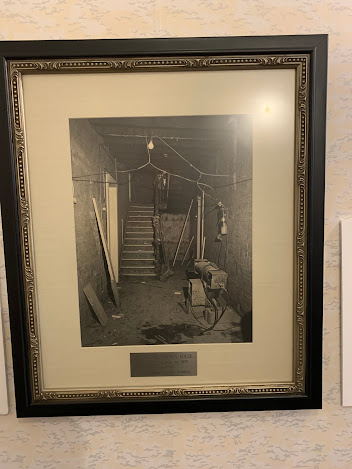One more bonus day so we took advantage of it and went into Lexington to see a few things. First stop, the Mary Todd Lincoln Home.
The home was built in 1806 is one of the oldest structures in Lexington. French immigrant William Palmateer built and operated it as an inn and tavern until financial troubles forced him to sell the property. It became the home of politician and businessman Robert S. Todd in 1832 when Mary was 13. She moved to Illinois in 1839 where she met and married Abraham Lincoln. They visited here in the fall of 1847. The Todds moved away after Robert S. Todd died in the 1849 cholera epidemic. After the Todds moved out, the property had many uses, including a boarding house, a grocery store, and even a brothel. By the 1950s, the structure, in poor shape, was being used for storage. In 1977 the house was restored and opened to the public as a museum.
The home is beautifully restored. Very interesting to see the stairwell before and after restoration.
There were "twin" parlors where the Todds received guests. The rooms were meant for informal gatherings, but the fine furnishings reflect the Todd's affluence.
The Todds, like so many families of their time, had a piano. I haven't found any evidence of Mary playing the piano but since she was a very accomplished child, she may have.
I love this desk and as my dad would have said, I can just visualize Mary sitting here writing letters.
The children's bedroom - I just love the cradle and can imagine a baby sleeping in it.
The parent's bedroom.
Mary Todd was born in Lexington as the fourth of seven children of Robert Smith Todd, a banker, and Elizabeth "Eliza" (Parker) Todd. When she was six, her mother died in childbirth. Two years later, her father married Elizabeth "Betsy" Humphreys and together they had nine children. Mary had a difficult relationship with her stepmother, some have referenced that she "despised" her. Therefore, Mary spent more time with her grandmother.
Mary had her own bedroom. Seems odd since there were a total of 15 children.
The pictures and portraits were plentiful and showed a variety of individuals.
When Mary moved to Springfield in 1839, she lived with her sister Elizabeth and her husband, Ninian Edwards, whose family was active in local politics As an attractive and accomplished member of a prominent household - her sister's father-in-law was a former governor of Illinois - Mary received much attention, particularly from Abraham Lincoln, then a struggling country lawyer with no firm prospects. Mary was popular among the gentry of Springfield and though she was courted by the rising young lawyer and Democratic Party politician Stephen A. Douglas and others, she chose Abraham Lincoln, a fellow Whig. After a tempestuous courtship in which Abraham once broke off their engagement, the couple married in 1842, despite Elizabeth's objections.
Elizabeth Todd Edwards
Many portraits of Mary throughout the home.
Mary Todd Lincoln, c. 1854
This was especially poignant - the Lincolns had already lost one of their sons.
Lincoln and Family by Louis Kurz and Alexander Allison
Copy of post-1880 lithograph, 1964
One of the most notable individuals interred here is Henry Clay. One of the least known of Henry Clay's accomplishments is the influence he had on a young native Kentuckian who transplanted to Illinois. The young Kentuckian, who sought a career in politics, was none other than Abraham Lincoln.
On July 6, 1852, at the Statehouse in Springfield, Lincoln delivered a stirring eulogy of his political idol. The eulogy emphasized Clay's devotion to liberty and praised him as a man "the times have demanded" In an ironic twist, Lincoln concluded "Let us strive to deserve, as far as mortals may, the continued care of Divine Providence, trusting that in future emergencies, He will not fail to provide us the instruments of safety and security."
On the "front" side of the monument was a very special tree.
There are a few other notables in the cemetery.
John Breckinridge (January 16, 1821-May 17, 1875) was an American lawyer, politician, and soldier. He represented Kentucky in both houses of Congress and became the 14th, and youngest ever, vice president of the United States serving from 1857-1861. He took office at the age of 36. He ran for president in 1860 as a Southern Democrat. He served in the Senate during the outbreak of the Civil War, but was expelled after joining the Confederate Army. He was appointed Confederate Secretary of War in 1865.
Unfortunately, it had already been a long day so we cut our visit and weren't able to visit the others.
What an unexpected visit and we were glad to have had the bonus time.






























This one has all kinds of fun tidbits of info. Things we wouldn't know about if not for our traveling Encyclopedia Britannica. By the size of that memorial one would think Henry Clay was a big cheese. It seems that Lincoln was about the only one who thought so.
ReplyDeleteHe was a big cheese in Kentucky. But I've seen several US Presidents with very small, unassuming grave stones.
DeleteAs a Lincolnphile (is there such a word?), I really enjoyed reading this!
ReplyDelete